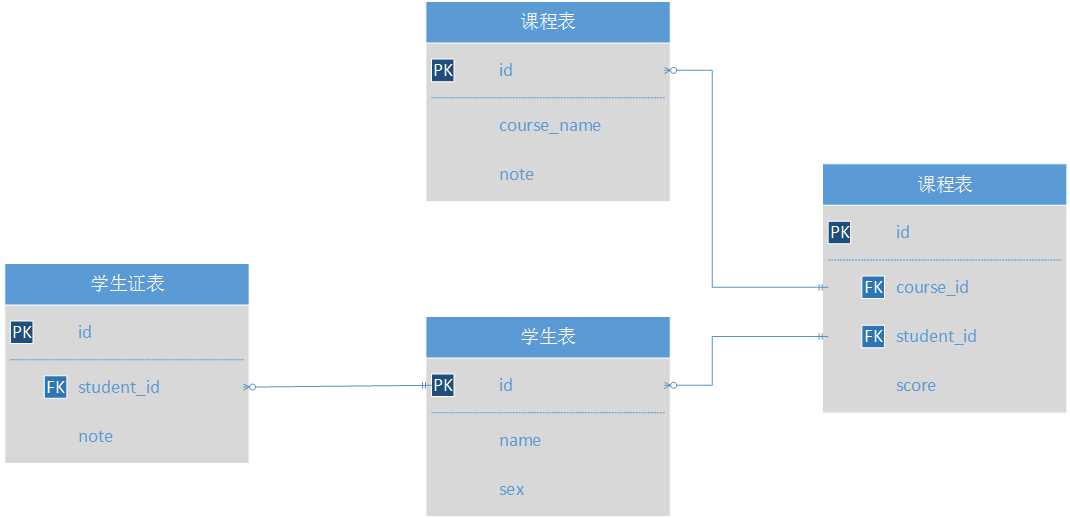标签:.com htm 哪些 iat 基础 学生 oct 单例 row
上次我们讲到了MyBatis的一对一关系的表示,简单回顾一下一对一关系就是一个学生只有一个学生证。那么什么是一对多关系呢?一个学生有多个课程这就是一对多的关系。我们结合上一章中的学生和学生证,在此基础上新增一个课程表和课程成绩表。学生对应课程表是一对多的关系,在学生确定的情况下课程表对应课程成绩是一对一的关系。我们先来看看我们所假设的场景数据结构的设计。
数据库的ER图如下(因为对数据库还处于菜鸟阶段……所以可能ER图绘制有误,但不影响我们讲解MyBatis一对多关系的级联):

再看看数据库的物理模型包含哪些字段:

数据库的设计就差不多了,接下来是设计我们的POJO类:
首先是Student类:
1 package day_8_mybatis.pojo; 2 3 import java.util.List; 4 5 /** 6 * @author turbo 7 * 8 * 2016年11月4日 9 */ 10 public class Student { 11 private int id; 12 private String name; 13 private String sex; 14 private SelfCard selfCard; //学生和学生证是一对一的关系,所以存放一个对学生证类的引用 15 private List<CourseScore> courseScoreList; //我们在一开始就提到过学生和课程是一对多的关系,所以学生POJO类中对课程类字段就是一个List用来存放学生的课程成绩。 16 //省略set/get方法 17 }
注意,我们有一个List字段是对课程成绩的引用而不是课程的引用。为什么呢?因为在我们数据库设计中,学生和课程是通过课程成绩联系起来的。
接着是我们的CourseScore类:
1 package day_8_mybatis.pojo; 2 3 /** 4 * @author turbo 5 * 6 * 2016年11月4日 7 */ 8 public class CourseScore { 9 private int id; 10 private int studentId; 11 private Course course; //在学生id确认的情况下,课程和成绩是一对一的关系。 12 private String score; 13 //省略set/get方法 14 }
最后是Course类:
1 package day_8_mybatis.pojo; 2 3 /** 4 * @author turbo 5 * 6 * 2016年11月4日 7 */ 8 public class Course { 9 private int id; 10 private String courseName; 11 private String note; 12 //省略set/get方法 13 }
现在我们是要通过一个学生ID,就能查询出这个学生的课程、以及对应课程的成绩。这个怎么来实现呢?在使用MyBatis为我们提供的级联前,我们先来梳理一下从逻辑上是怎么一步一步查询出来的。
我们要通过学生id查询出学生的基本信息(包括课程以及对应的成绩),但在学生POJO类中有一个对课程成绩的List引用(暂时忽略学生证),也就是说我们无法一条简单的sql语句(无join的sql语句)查询出结果。但是!我们可以通过student_id在课程成绩表中查询出该学生的相应课程id(注意此时还是id),但我们此时还是没办法知道具体的课程名,再利用我们上一步中student_id查询出的course_id通过课程表再来查询出对应的课程名。重新梳理一下:
那我们现在就从最底层做起,也就是通过course_id查询出具体课程,因为这不会涉及到其他表。
1 package day_8_mybatis.mapper; 2 3 import day_8_mybatis.pojo.Course; 4 5 /** 6 * @author turbo 7 * 8 * 2016年11月4日 9 */ 10 public interface CourseMapper { 11 Course getCourse(int id); //此id为course_id 12 }
再来看看mapper映射,也是非常简单。
1 <?xml version="1.0" encoding="UTF-8"?> 2 <!DOCTYPE mapper 3 PUBLIC "-//mybatis.org//DTD Mapper 3.0//EN" 4 "http://mybatis.org/dtd/mybatis-3-mapper.dtd"> 5 <mapper namespace="day_8_mybatis.mapper.CourseMapper"> 6 <select id="getCourse" parameterType="int" resultType="day_8_mybatis.pojo.Course"> 7 select id, course_name as courseName, note from t_course where id = #{id} 8 </select> 9 </mapper>
现在已经写好了通过course_id来查询出具体课程。那么就是倒着走到第2步,通过student_id在t_course_score表中查询学生对应的course_id,在最开始说过,在学生确定的情况下,课程和课程成绩是一对一的关系,关于一对一的关系我们在上一篇已经讲过,不妨再重温一下。
1 package day_8_mybatis.mapper; 2 3 import day_8_mybatis.pojo.CourseScore; 4 5 /** 6 * @author turbo 7 * 8 * 2016年11月4日 9 */ 10 public interface CourseScoreMapper { 11 CourseScore findCourseScoreByStudentId(int id); 12 }
再来看看mapper映射,也是非常简单。
1 <?xml version="1.0" encoding="UTF-8"?> 2 <!DOCTYPE mapper 3 PUBLIC "-//mybatis.org//DTD Mapper 3.0//EN" 4 "http://mybatis.org/dtd/mybatis-3-mapper.dtd"> 5 <mapper namespace="day_8_mybatis.mapper.CourseScoreMapper"> 6 <resultMap id="courseScoreMap" type="day_8_mybatis.pojo.CourseScore"> 7 <id property="id" column="id"/> 8 <result property="studentId" column="student_id"/> 9 <result property="score" column="score"/> 10 <association property="course" column="course_id" select="day_8_mybatis.mapper.CourseMapper.getCourse" /> <!--将查询出来的course_id交给CouseMapper来查询出具体课程信息--> 11 </resultMap> 12 13 <select id="findCourseScoreByStudentId" parameterType="int" resultMap="courseScoreMap"> 14 select id, student_id, course_id, score from t_course_score where student_id = #{id} 15 </select> 16 </mapper>
最后一步,也就是第1步,才进入正题MyBatis的一对多collection级联关系。
1 package day_8_mybatis.mapper; 2 3 import day_8_mybatis.pojo.Student; 4 5 /** 6 * @author turbo 7 * 8 * 2016年11月4日 9 */ 10 public interface StudentMapper { 11 Student getStudent(int id); 12 }
关键在mapper映射中。
1 <?xml version="1.0" encoding="UTF-8"?> 2 <!DOCTYPE mapper 3 PUBLIC "-//mybatis.org//DTD Mapper 3.0//EN" 4 "http://mybatis.org/dtd/mybatis-3-mapper.dtd"> 5 <mapper namespace="day_8_mybatis.mapper.StudentMapper"> 6 <resultMap type="day_8_mybatis.pojo.Student" id="studentMap"> 7 <id property="id" column="id"/> 8 <result property="name" column="name"/> 9 <result property="sex" column="sex"/> 10 <association property="selfCard" column="id" select="day_8_mybatis.mapper.SelfCardMapper.findSelfCardByStudentId"/> 11 <collection property="courseScoreList" column="id" select="day_8_mybatis.mapper.CourseScoreMapper.findCourseScoreByStudentId" /> 12 </resultMap> 13 <select id="getStudent" parameterType="int" resultMap="studentMap"> 14 select id, name, sex from t_student where id = #{id} 15 </select> 16 </mapper>
请好好仔细品味品味,仔细回顾整个查询的逻辑过程。collection就是MyBatis为我们提供的第二个级联关系——一对多。
最后上我们的测试代码:
1 package day_8_mybatis; 2 3 import java.io.IOException; 4 import java.io.InputStream; 5 6 import org.apache.ibatis.io.Resources; 7 import org.apache.ibatis.session.SqlSession; 8 9 import day_8_mybatis.mapper.StudentMapper; 10 import day_8_mybatis.pojo.Student; 11 import day_8_mybatis.util.SessionFactory2; 12 13 /** 14 * 客户端 15 * @author turbo 16 * 17 * 2016年11月4日 18 */ 19 public class Main { 20 21 /** 22 * @param args 23 * @throws IOException 24 */ 25 public static void main(String[] args) throws Exception { 26 String resource = "day_8_mybatis/mybatis-config.xml"; //获取mybatis配置文件路径 27 InputStream inputStream = Resources.getResourceAsStream(resource); 28 SqlSession sqlSession = SessionFactory2.getInstance(inputStream).openSession(); 29 StudentMapper studentMapper = sqlSession.getMapper(StudentMapper.class); 30 Student student = studentMapper.getStudent(1); 31 System.out.println("学生:" + student.getName() + " 课程:" + student.getCourseScoreList().get(0).getCourse().getCourseName() + " 分数:" + student.getCourseScoreList().get(0).getScore()); 32 33 } 34 35 }
//还是把day_8_mybatis.util.SessionFactory2代码贴出来吧,SqlSessionFactory用到了单例模式,这也是MyBatis官方文档所提倡的,具体可以移步之前写的几个关键类的作用域问题,《SqlSessionFactoryBuilder、SqlSessionFactory、SqlSession作用域(Scope)和生命周期》,也可移步至《单例模式》、《再说单例模式的线程安全问题》了解单例模式。
1 package day_8_mybatis.util; 2 3 import java.io.InputStream; 4 5 import org.apache.ibatis.session.SqlSessionFactory; 6 import org.apache.ibatis.session.SqlSessionFactoryBuilder; 7 8 /** 9 * @author turbo 10 * 11 * 2016年10月26日 12 */ 13 public class SessionFactory2 { 14 private static SqlSessionFactory sqlSessionFactory; 15 16 public static synchronized SqlSessionFactory getInstance(InputStream inputStream){ 17 if (null == sqlSessionFactory){ 18 sqlSessionFactory = new SqlSessionFactoryBuilder().build(inputStream); 19 } 20 21 return sqlSessionFactory; 22 } 23 }
标签:.com htm 哪些 iat 基础 学生 oct 单例 row
原文地址:http://www.cnblogs.com/yulinfeng/p/6034256.html